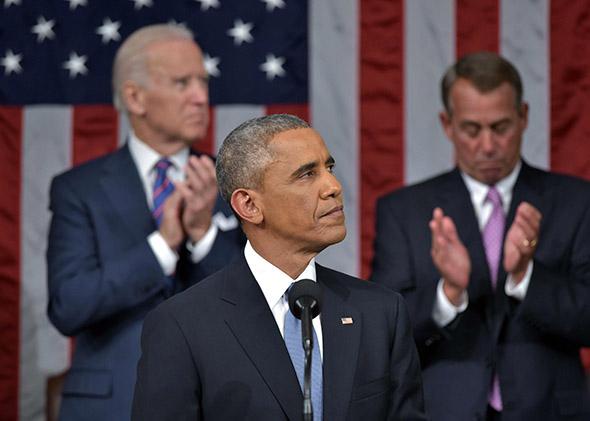If you only judged by the pomp and circumstance of the event, you’d assume that the State of the Union address was a singular product of the president and his administration, a bold statement of his priorities, his goals, and his agenda. And this is partly true. The speech President Obama gave Tuesday night was likely different from the one a President Hillary Clinton would have given if she were elected in 2008. At the same time, this agenda isn’t formed in a vacuum; it’s a collective affair, and specifically, a product of the party the president represents.
The best way to understand the State of the Union, in other words, is as a statement in the constant conversation between the president and his party. In his sixth such address—as it’s been since the beginning of his presidency—his message was as mediated by party debates as it was bounded by party limits.
And if you want to see how the political and ideological limits of the Democratic Party have expanded since the 2012 election, just look at the scope of Obama’s rhetoric. Following the path paved by Massachusetts Sen. Elizabeth Warren—who has captured the energy of the Democratic grass roots—Obama has offered a muscular defense of the party’s liberalism and the programs it has produced.
“[A]t every moment of economic change throughout our history, this country has taken bold action to adapt to new circumstances, and to make sure everyone gets a fair shot,” said Obama, detailing his vision for a “middle-class economics.” “We set up worker protections, Social Security, Medicare, and Medicaid to protect ourselves from the harshest adversity. We gave our citizens schools and colleges, infrastructure and the Internet—tools they needed to go as far as their effort will take them,” he continued.
His vision—and thus the Democratic Party’s—is to expand this even further with a new set of policies, ranging from free community college and a continued commitment to universal health insurance, to child care subsidies, paid sick leave, equal pay for women, and a higher minimum wage. Indeed, this list stands as a direct answer to the core question of the political moment: How can our government deliver the gains of economic growth to ordinary people?
It’s worth noting that none of this is out of sync with the Democratic Party’s agenda through the 20th century. In his own sixth-year State of the Union address, President Bill Clinton touted Social Security and proposed a tax credit for long-term care of the disabled. The difference is that Obama has almost abandoned the “Third Way” approach of his Democratic predecessor. Where Clinton proposed private accounts for Social Security, touted deficit reduction, and called for Congress to toughen its drug laws, Obama has pushed for infrastructure spending, ignored presidential ledger counting, and asked Congress to “reform America’s criminal justice system so that it protects and serves us all.”
If anything, Obama’s confident, assertive liberalism is a return to the immediate postwar era, when Democratic governance was broadly popular and ascendant. “I think everybody knows that social insurance and better schools and health services are not frills, but necessities in helping all Americans to be useful and productive citizens, who can contribute their full share in the national effort to protect and advance our way of life,” said President Truman in his 1952 address, the sixth and final one of his presidency. The rhythm is different but the rhyme is the same: Government has a place in securing prosperity and protecting ordinary people.
With that said, there are still limits to the scope of this new Democratic liberalism. Obama’s speech was strong, but his agenda was relatively modest. Even if Congress adopted all of Obama’s economic proposals, it would put just a small dent in the towering inequality that defines modern American life. Core problems of wage stagnation, social mobility, and retirement security remain unaddressed by most Democrats. Explicit redistribution for all Americans—of the kind we see in our entitlement programs—is still largely off the table. Policies that would unambiguously boost incomes—broader and higher subsidies in the Affordable Care Act, direct wage assistance, an expanded Social Security program for retirees—haven’t reached the mainstream of the Democratic Party.
But it’s now clear, from this State of the Union to statements from key party elites, that inequality will stand as the main agenda item of the post-Obama Democratic Party. The questions now, and the ones Democrats will fight over in the coming presidential primaries, are of ambition. Are the modest policies of the late Obama administration enough? Or do we need something more drastic to bring our economy back into balance?
